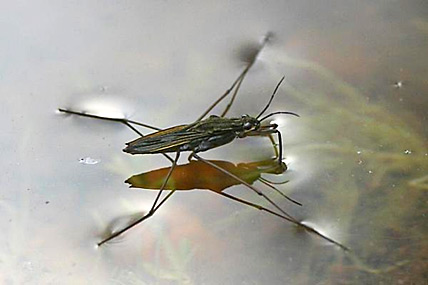In the serene atmosphere of a pond, teeming with life and swathed in the tranquility of nature, one often overlooks the ephemeral yet captivating inhabitants that abound in these aquatic environments. Among them lies the fascinating entity known as the pond skater, a member of the family Gerridae, whose presence offers intriguing insights into the intricate tapestry of ecosystems. What appears to be mere surface skimming may signify a much deeper meaning—an ode to the resilience of nature and its adeptness in the face of varying environmental circumstances.
Pond skaters are truly remarkable, not merely for their physical characteristics but for their ecological roles as well. With their elongated bodies and long legs, which can span several centimeters, these insects are adept at locomotion over the water’s surface—a feat made possible by their unique adaptations. Their legs are equipped with tiny, hydrophobic hairs that trap air, allowing them to stand on the water’s surface tension without submerging. This not only provides them with the ability to traverse the pond with grace and agility but also equips them for survival against predators lurking beneath the mirrored surface.
The pond skaters are easily recognizable due to their dazzling black or dark brown coloration, which camouflages them against the debris often found atop the water’s surface. This cryptic coloration is not just an aesthetic marvel; it is a crucial element of their survival strategy. By blending into their surroundings, pond skaters can evade predators, ensuring their continued existence in the competitive aquatic ecosystem.
However, pond skaters are not merely passive entities. They are poised hunters, exhibiting predatory behaviors that are both fascinating and essential to the ecosystem. Using their sharp forelegs, they capture unsuspecting prey, primarily consisting of small invertebrates. The pond skaters deliver a piercing bite, injecting enzymes that pre-digest their prey. This predation serves as a natural population control for many aquatic creatures, highlighting the pond skater’s role as a vital cog in the intricate machinery of the pond ecosystem.
As one observes these agile insects, it becomes evident that their movements on the water’s surface are not only purposeful but also exhibit a distinct social structure. Pond skaters are known for their gregarious nature, often congregating in groups that float seamlessly together. This social comportment allows them to better defend themselves against potential threats while increasing their success in hunting. Their collective behavior demonstrates a complex understanding of their environment, where cooperation plays an invaluable role in their survival.
Moreover, the reproductive strategies of pond skaters reveal another layer of complexity. Mating rituals can be quite elaborate, characterized by a form of courtship that involves intricate dance-like movements upon the water’s surface. Females possess the ability to lay eggs in the vicinity of suitable water bodies, ensuring that their offspring are enveloped in a nurturing environment. This instinctive behavior highlights the strong connection these skaters have with their habitat, reinforcing the notion that every action they take has significance.
What is particularly striking about pond skaters is their resilience. The dynamics of their environments significantly affect their populations and behaviors. For instance, changes in pond water levels, temperature fluctuation, and pollution can radically impact their survival and reproductive success. In times of drought, pond skater populations may dwindle, while in well-preserved habitats, they flourish. This adaptability is a testament to the evolutionary sophistication these creatures embody. It starkly reminds us of the fragility of our ecosystems and the pressing need for conservation efforts to protect these enchanting beings.
The presence of pond skaters can serve as an indicator of ecological health within freshwater environments. Their sensitivity to environmental changes allows them to act as bioindicators. An abundance of pond skaters may signify a healthy ecosystem teeming with biodiversity, while a decline in their numbers could reflect adverse conditions. Monitoring their populations provides critical insights into broader ecological shifts, emphasizing the interconnectedness of life in a pond.
In summary, the pond skater, with its graceful gliding and predatory prowess, is much more than an insect drifting across the water’s glassy surface. It embodies a connection to the deeper meanings inherent in the natural world—resilience, cooperation, and an ongoing dance of existence that echoes throughout the tapestry of life. As we gaze upon a pond skater skimming along the water, we are impelled to reflect on our role within this intricate web of life. Just as the skaters glide upon their liquid domain, we must also tread lightly, respecting and preserving the delicate balance of the ecosystems we encounter.
Let us cherish the pond skater, for it embodies the essence of life’s complexity and the unyielding spirit of survival in the face of adversity. As we enlighten ourselves about such remarkable creatures, we gain a profound appreciation for the wonders surrounding us—each reflection on the water leads us to a deeper understanding of the world’s fragility and beauty.









Leave a Comment